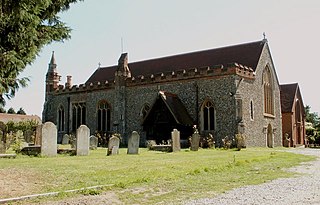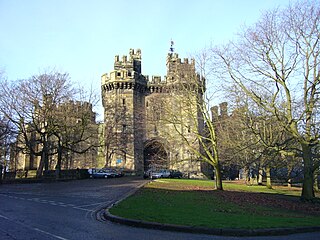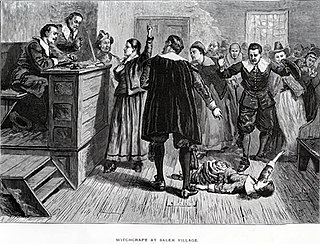Related Research Articles

The Salem witch trials were a series of hearings and prosecutions of people accused of witchcraft in colonial Massachusetts between February 1692 and May 1693. More than 200 people were accused. Thirty people were found guilty, nineteen of whom were executed by hanging. One other man, Giles Corey, died under torture after refusing to enter a plea, and at least five people died in jail.
The Witchcraft Acts were a historical succession of governing laws in England, Scotland, Wales, Ireland, and the British colonies on penalties for the practice, or—in later years—rather for pretending to practice witchcraft.

St Osyth is an English village and civil parish in the Tendring District of north-east Essex, about 5 miles (8.0 km) west of Clacton-on-Sea and 12 miles (19.3 km) south-east of Colchester. It lies on the B1027, Colchester–Clacton road. The village is named after Osgyth, a 7th-century saint and princess. Locally, the name is sometimes pronounced "Toosey". It is claimed to be the driest recorded place in the United Kingdom.
John Proctor was a landowner in the Massachusetts Bay Colony. He and his wife Elizabeth were tried and convicted of witchcraft as part of the Salem Witch Trials, whereupon he was hanged.
Elizabeth Proctor was convicted of witchcraft in the Salem Witch Trials of 1692. She was the wife of John Proctor, who was convicted and executed.

Tituba was a Native American slave woman who was one of the first to be accused of witchcraft during the Salem witch trials of 1692–1693.

Hatfield Peverel is a village and civil parish at the centre of Essex, England. It is located 6 miles (10 km) north-east from Chelmsford, the nearest large city, to which it is connected by road and rail. The parish includes the hamlets of Nounsley and Mowden. Hatfield means a 'heathery space in the forest'; Peverel refers to William Peverel, the Norman knight granted lands in the area by William the Conqueror after the Norman invasion of 1066. Sited on high ground east of the River Ter, between Boreham and Witham on the A12, it is situated in the southern extremity of the Braintree District Council area. In 2020, the built-up area subdivision had an estimated population of 3,226. In 2011, the built-up area which includes Nounsley had a population of 3,950 and the parish had a population of 4,376.

The Bideford witch trial resulted in hangings for witchcraft in England. Temperance Lloyd, Mary Trembles and Susannah Edwards from the town of Bideford in Devon were tried in 1682 at the Exeter Assizes at Rougemont Castle. Much of the evidence against them was hearsay, although there was a confession by Lloyd, which she did not fully recant even with her execution imminent. These women have been labelled as the last witches to be hanged in England, but there are subsequent cases which are not as well documented.

Susannah Martin was one of fourteen women executed for the suspicion of practicing witchcraft during the Salem witch trials of colonial Massachusetts.
Dorcas Hoar was a widow accused of witchcraft during the Salem witch trials of 1692. She was found guilty and condemned to hang, but then confessed and with the support of several ministers, was given a temporary reprieve, after which the trials had already ended.
Ursula Kemp or Ursley Kempe alias Grey was an English cunning woman and midwife who in 1582 was tried for witchcraft and hanged. Kemp was accused of using familiars to kill and bring sickness to her neighbour.

The trials of the Pendle witches in 1612 are among the most famous witch trials in English history, and some of the best recorded of the 17th century. The twelve accused lived in the area surrounding Pendle Hill in Lancashire, and were charged with the murders of ten people by the use of witchcraft. All but two were tried at Lancaster Assizes on 18–19 August 1612, along with the Samlesbury witches and others, in a series of trials that have become known as the Lancashire witch trials. One was tried at York Assizes on 27 July 1612, and another died in prison. Of the eleven who went to trial – nine women and two men – ten were found guilty and executed by hanging; one was found not guilty.
Abigail Faulkner, sometimes called Abigail Faulkner Sr., was an American woman accused of witchcraft during the Salem witch trials in 1692. In the frenzy that followed, Faulkner's sister Elizabeth (Dane) Johnson (1641–1722), her sister-in-law Deliverance Dane, two of her daughters, two of her nieces, and a nephew, would all be accused of witchcraft and arrested. Faulkner was convicted and sentenced to death, but her execution was delayed due to pregnancy. Before she gave birth, Faulkner was pardoned by the governor and released from prison.

The Samlesbury witches were three women from the Lancashire village of Samlesbury – Jane Southworth, Jennet Bierley, and Ellen Bierley – accused by a 14-year-old girl, Grace Sowerbutts, of practising witchcraft. Their trial at Lancaster Assizes in England on 19 August 1612 was one in a series of witch trials held there over two days, among the most infamous in English history. The trials were unusual for England at that time in two respects: Thomas Potts, the clerk to the court, published the proceedings in his The Wonderfull Discoverie of Witches in the Countie of Lancaster; and the number of the accused found guilty and hanged was unusually high, ten at Lancaster and another at York. All three of the Samlesbury women were acquitted.

Elizabeth Booth was born in 1674 and was one of the accusers in the Salem Witch Trials. She grew up in Salem, Massachusetts, as the second eldest of ten children. When she was sixteen she was accused of being a witch. When she was eighteen, she began accusing people of practicing witchcraft, including John Proctor, Elizabeth Proctor, Sarah Proctor, William Proctor, Benjamin Proctor, Woody Proctor, Giles Corey, Martha Corey, Job Tookey, and Wilmont Redd. Five of these people were executed due to Booth's testimony. Elizabeth Proctor would have been executed as well if she was not pregnant. After the Witch Trials, Booth married Israel Shaw on December 26, 1695, and had two children named Israel and Susanna. Booth's death date is unknown.
The Channel Islands Witch Trials were a series of witch trials in the Channel Islands of Jersey and Guernsey between 1562 and 1661.
Grace White Sherwood (1660–1740), called the Witch of Pungo, is the last person known to have been convicted of witchcraft in Virginia.

Martha Carrier was a Puritan accused and convicted of being a witch during the 1692 Salem witch trials.

The Maryland Witch Trials were a series of hearings and prosecutions of people accused of witchcraft in Colonial Maryland between June 1654, and October 1712. It was not unique, but is a Colonial American example of the much broader phenomenon of witch trials in the early modern period, which took place also in Europe.

During a 104-year period from 1626 to 1730, there are documented Virginia Witch Trials, hearings and prosecutions of people accused of witchcraft in Colonial Virginia. More than two dozen people are documented having been accused, including two men. Virginia was the first colony to have a formal accusation of witchcraft in 1626, and the first formal witch trial in 1641.
References
- ↑ Gibson, Marion (2022). The Witches of St Osyth. Cambridge University Press. doi:10.1017/9781108859608. ISBN 978-1-108-49467-0. S2CID 254201219.
- 1 2 3 Gibson, Marion (2022). The Witches of St Osyth. Cambridge University Press. pp. 10–11, 51. ISBN 978-1-108-49467-0.